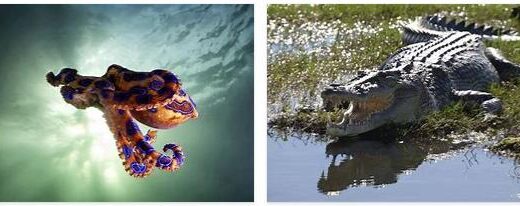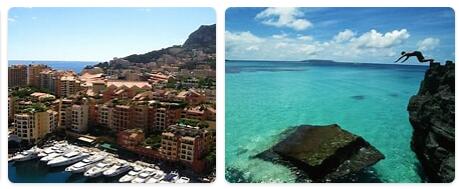Kiribati Country Overview
Kiribati. An island state of Oceania, it is made up of several island groups (Gilbert, Banaba, Phoenix and Line Islands), distributed in an extensive strip of the Pacific Ocean around the Equator line. It is the only country in the world crossed by the international date line.
The Kiribati archipelago, crossed by Ecuador, is located in the northeastern part of the Pacific Ocean, at the extreme end of the typhoon zone, and is located between the Tuvalu Islands, to the South, and the Marshall Islands, to the North. They were formerly called Gilbert Islands.
Geography
Relief
According to TOPB2BWEBSITES, the islands of Kiribati, with the exception of Bañaba, are coral atolls that have formed on a submerged mountain range and are surrounded by reefs. The average height of the atolls does not exceed 8 m, except for the island of Bañaba, made of coral covered with phosphate rock, which exceeded 80 m before the mineral was exploited.
The archipelago occupies an area of approximately 3,220,000 km2 (more than 3,200 km from east to west by more than 1,600 km from north to south) of the northwestern Pacific. The islands Tokelau and Tuvalu, in the south, and Nauru, in the west, share the vicinity of these waters endowed with abundant fish.
Climate
From March to October the trade winds blow from the northwest, making the weather pleasant. In the remaining months the weather is unstable, often with abundant rainfall due to strong storms coming from the west. Average temperatures range from 27 ° C to 32 ° C, although much higher temperatures are sometimes recorded.
The rainfall regime is quite variable depending on the geographical area in question; They range from 1,000 mm in the islets located on the equator to 3,000 mm in those found in the extreme north and south of the archipelago. Despite these precipitations, there is often a shortage of water mainly due to the low altitude of the terrain.
Flora and fauna
The vegetation is scarce, since the soil is arid and saline. The most common species are coconut palms, pandanos, and breadfruit trees.
Economic development
Agriculture (including fishing) contributes approximately 30% to Kiribati’s Gross Domestic Product (GDP) and employs the majority of the working population. The main crops for export are coconut and copra (72% of what was exported in 1988). The bananas, pandanus, trees bread and papayas are grown for domestic consumption. Rice, wheat flour and meat are imported to meet the food needs of the population. The fish accounted for 28% of export earnings in 1988. Some 19% of the 1988 budget income came from the sale of fishing permits to foreign fleets, a considerable source of resources.
Industry contributed 8.75% to GDP in 1988. Phosphate mining on Bañaba Island, which ceased in 1979, contributed 80% of export earnings. Interests in a phosphate reserve fund, established in 1956, continued to provide significant income during the 1980s. In 1988, feasibility studies were resumed to resume phosphate extraction. Salt is also produced, obtained with solar evaporation.
Manufacturing contributed 1.8% to GDP in 1988 and is reduced to small-scale production of coconut products, soap, food, handicrafts, and clothing.
Kiribati is a member of the South Pacific Forum and the South Pacific Commission. According to the UN, Kiribati is one of the least developed countries in the world. The end of the exploitation of phosphate in 1979 deprived it of its largest source of export resources. Fluctuations in the world copra market and its need to import almost everything it consumes are reflected in a constant trade deficit, as well as a permanent dependence on foreign aid.
A five-year plan (1988 – 1992) was carried out to balance the national budget, which aims to: use natural resources, promote self-sufficiency, replace imports, improve communications, develop the most remote islands and diversify sources of funds. In 1989, the UN Development Program outlined a plan to stimulate economic growth in the Line Islands, emphasizing the development of infrastructure, agriculture, and tourism. The Asian Development Bank partially finances these works.
Demography
The Gilbert Islands concentrate a high demographic density, due to the fact that 90% of the residents reside there, and of these a third do so in the capital, on the island of Tarawa. The people of Kiribati generally live in traditional villages and travel by canoe, although the islet of Bairiki in Tarawa has some modern buildings.
The population growth of almost 2% per year is more than the meager national territory can accommodate. To alleviate this problem, in 1988 the government announced a plan to relocate some 5,000 residents to further atolls, some 3,000 km from Tarawa. At the end of 1988, a program was started to provide electricity to the islands of North Tarawa, with the purpose of decongesting those of South Tarawa by 1991. More than 200 people had already moved in September of 1989.
Social development
Health
The government provides free medical services to the entire population. In Tarawa there are two hospitals and in each atoll there is also a dispensary with medical assistance. The most common diseases are tuberculosis, infantile diarrhea, and bacillary dysentery.
Education
Each inhabited island has at least one primary school, some of them parochial. Education is compulsory between the ages of six and fourteen (generally six years of primary school and three years of secondary school) with 92% attendance at elementary education. In 1988 there were 113 primary schools and seven secondary schools; 513 students in the vocational and technical institutes and 124 students in the state teacher training college. The naval training school, also a governmental one, prepares about 200 sailors a year to work in overseas shipping companies. Kiribati also participates in the University of the South Pacific, which is headquartered in Fiji.
Ethnic groups
The predominant ethnic group among the residents of Kiribati is Micronesia, although there are small groups of Polynesians and foreigners. The main languages are Gilbertés (i-Kiribati) and English (only spoken in Tarawa).
Religion
The most widespread creed is Christianity, in different variants. The Phoenix Islands do not have permanent residents; only people who travel there for work reasons. Of the rest of the atolls, only 20 are populated.
Communication
Four periodicals are published in the archipelago: the Atoll Pioneer (weekly of the Department of Information), the Te Uekera (weekly in English and i-kiribati, with a circulation of 1,500 copies), the Te Itoi ni Kiribati (monthly, Catholic, 2,000 copies in print) and Te Kaotan te Ota (Protestant quarterly publication, 1,700 copies in print). Radio Kiribati broadcasts from Bairiki, Tarawa, in English and i-kiribati.
Labor union
The Kiribati Trade Union Congress (KTUC) associates several unions.
Capital
Bairiki: Capital of Kiribati, this city is located on the Tarawa atoll and communicates with the other islands by air. Copra and phosphates are exported from its port.
Curiosities
In these islands it seems that everything is provided by nature. Even the breadfruit, whose bulky, rough fruits, about 10 cm long, can be eaten raw, cooked, roasted or fried, as well as reduced to flour and pasta.



